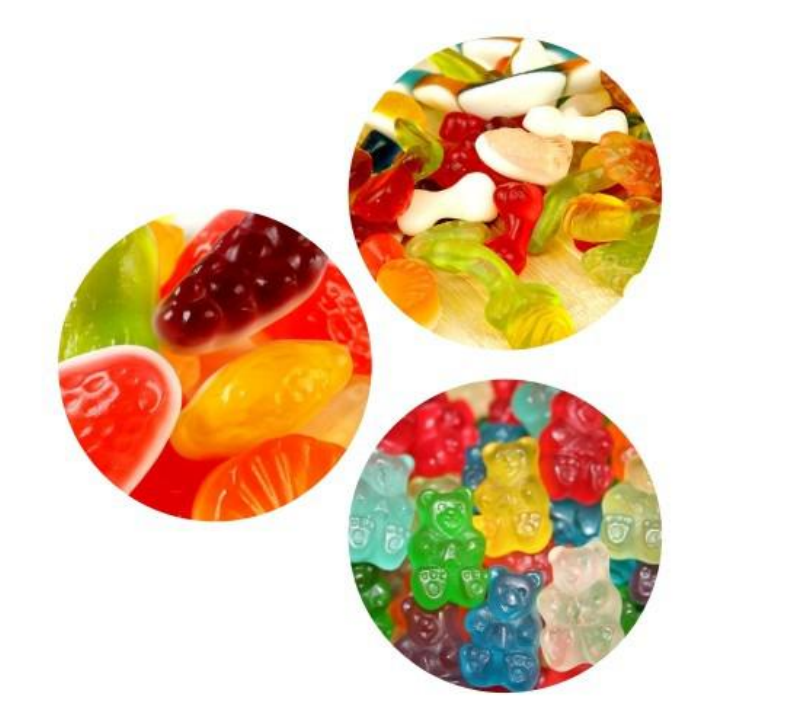Do you know HARIBO produces more than 160 million gummy bears every single day? This number shows just how much the world loves gummy candy.
From gummy bears and worms to sour twists and fruit shapes, these chewy sweets have become an everyday snack for millions. In fact, gummy candies now rank among the fastest-growing segments in the non-chocolate confectionery market.
So, are you ready to know more about these gummy candies? Let’s begin.
What is Gummy Candy?

Gummy candy is a soft, chewy treat made from gelatin, sugar, and flavorings, molded into fun shapes like bears, worms, and fruit. Both kids and adults love these colorful sweets for their bounce, bite, and endless variety.
They’re not just popular, they’re everywhere. The global gummy candy market is booming and is expected to reach $48.5 billion by 2028. Driven by demand for both traditional sweets and gummy vitamins, the market continues to grow.
Who Invented Gummy Bears?

Gummy bears were invented by a German candy maker named Hans Riegel in the early 1920s. He founded the famous candy company Haribo in 1922 and created the first gummy bear, originally called the “Dancing Bear” (Tanzbär in German).
Reigel got the idea by watching trained bears perform at festivals, and wanted to create a bear-shaped treat that was fun to eat. These original gummy bears were a bit larger and firmer than the ones we know today.
How Many Types of Gummy Candy Are There?

There’s a whole universe of gummy candy beyond just bears. Today, gummies come in all kinds of shapes, flavors, and even functions. Here’s a closer look:
1. Gummy Bears & Worms
These are the classics. Gummy bears, first created in Germany in the 1920s, have remained a favorite ever since. Gummy worms came along in the 1980s, quickly gaining popularity for their playful shape and extra chewiness.
Fun fact: The number of gummy bears produced every day would be enough to circle the Earth four times a year.
2. Sour Gummies
These come coated in sugar or citric acid for that mouth-puckering punch. Sour gummy worms, belts, and keys are some of the most popular. They’re especially big with teens and younger adults.
Sour Patch Kids stands out as one of the top sour gummy brands, generating over $100 million in annual sales in the U.S.
3. Vitamin & Enhanced Gummies
Not all gummies are just for fun. Today, many people take vitamins in gummy form, including vitamin C, melatonin, and apple cider vinegar. These are popular with adults who want a tastier alternative to pills.
4. Seasonal & Limited-Edition Gummies
Holidays bring their own gummy trends, such as red and green trees for Christmas, ghost-shaped gummies for Halloween, or heart-shaped ones for Valentine’s Day. These are often sold in themed packaging and are available only for a short time.
What Is Gummy Candy Made Of?
Gummy candy is all about that irresistible chewy texture, which comes from a mix of a few key ingredients. The main ingredient is gelatin, a protein made from animal collagen. This is what gives gummies their bounce and squish.
Alongside gelatin, you’ll find sweeteners like sugar or corn syrup that provide the sweetness and help create a smooth texture. Moreover, to make each gummy tasty and eye-catching, manufacturers add flavorings and colors.
For sour varieties, citric acid provides the tangy bite and also works as a natural preservative.
Are All Gummies Gluten-Free?
Most gummy candies are naturally gluten-free, especially if they don’t include wheat-based glucose syrup or flour. However, some brands may process their gummies in facilities that handle gluten, which can lead to cross-contamination.
How Much Sugar Is in Gummies?
Gummy candies are sweet for a reason, because they’re packed with sugar. A standard serving (about 17–20 gummy bears) usually contains 14 to 22 grams of sugar, depending on the brand and type. That’s nearly the same as drinking half a can of soda.
Are There Any Benefits of Eating Gummies?
Even though gummy candy is usually seen as a treat, there are a few benefits, especially when enjoyed in moderation. Here are a few benefits of eating gummies in moderation.
1. Portion Control
Gummies are naturally easy to portion. Unlike snacks that come in large servings, you can enjoy just a few and stop, making it easier to avoid overindulgence. With growing awareness around mindful eating, many people now prefer portion-controlled treats over bulk-sized options.
2. Portability and Convenience
Gummy candies are light, small, and don’t melt easily. You can toss them in your bag or pocket and enjoy them anytime, anywhere, without needing a fridge or a napkin.
3. Mood Boost
There’s something nostalgic and satisfying about chewing gummy candy. That chewy texture and sweet burst of flavor can lift your mood when you need a quick pick-me-up. Not only that, but chewing gum, whether gum or gummies, has also been shown to reduce cravings and the likelihood of oversnacking.
4. A Fun Way to Take Supplements
Today, many brands are creating vitamin gummies, CBD-infused options, and even collagen or melatonin gummies. These provide nutritional support in a form that’s way more fun and convenient than swallowing pills. Interestingly, of all the vitamin users, 41% prefer vitamins in gummy form.
What Are the Disadvantages of Gummies?
Gummies may be fun and flavorful, but they come with a few downsides, especially if you eat them without moderation. Here are the disadvantages of gummies:
1. High in Sugar
Most gummy candies are packed with sugar, often containing 15 to 30 grams or more per pack. Consuming too much sugar is linked to issues like weight gain, insulin resistance, and tooth decay. According to the CDC, added sugars should make up less than 10% of your daily calories, but just a few gummies can easily exceed that limit.
2. Artificial Colors and Flavors
Bright colors and strong flavors often come from artificial additives. Some studies, including reviews published on the National Institute of Health, suggest a possible link between synthetic dyes and hyperactivity in children. While the science isn’t conclusive, it’s enough to make many parents cautious.
3. Bad for Dental Health
Gummies are sticky by nature, which makes them more likely to cling to teeth. This residue feeds the bacteria that lead to plaque buildup and cavities. The American Dental Association (ADA) lists chewy candies like gummies among the worst options for dental health if you don’t brush soon after eating.
4. Not Always Vegan or Allergy-Friendly
Traditional gummies are made from gelatin, which comes from animal collagen. This makes them unsuitable for vegans. Plus, not all brands are gluten-free, and some may include allergens like soy or dairy-based additives. Always make sure to check the label.
How Are Gummies Used Today?
Gummies aren’t just for kids or candy aisles anymore. Today, they’ve expanded into everyday life, from fun treats to serious wellness tools.
1. For Fun and Snacking
Gummies are still a classic choice for parties, gifts, and personal snacking. Gummy bears, worms, rings, and sour bites are a hit at birthdays, movie nights, and as quick pick-me-ups during the day.
Their chewy texture and fruity flavors make them a favorite for all ages. Moreover, seasonal gummies like Halloween pumpkins or Christmas trees add a festive twist that boosts their popularity during holidays.
2. For Health and Wellness

These gummy candies became the go-to option for vitamins and supplements. From multivitamins to melatonin, CBD, collagen, and apple cider vinegar, wellness gummies are changing the way people stay healthy.
They’re easier to chew than pills and more enjoyable to take, especially for children, seniors, and anyone with pill fatigue.
Summing Up
Gummy candy has come a long way in all these years. Their chewy texture, fun shapes, and endless flavors make them irresistible for all ages. Whether you love classic gummy bears, need a quick vitamin boost, or want a sweet party treat, there’s a gummy for that.
With their growing popularity and new health-focused uses, gummies aren’t going anywhere. Just remember to enjoy them in moderation, check the labels if you have dietary needs, and maybe even try a functional gummy next time.
FAQs
1. How long do gummies last?
Gummies usually last 6 to 12 months if you keep them in a cool, dry place. Make sure to store them in an airtight container to keep them fresh. If they look hard, sticky, or have changed colors, it’s time to toss them out. Always check the package for best-by dates.
2. Are there vegan gummy options?
Yes! Many brands now offer vegan gummies made from gelatin. They use plant-based ingredients like pectin or agar-agar instead. These are just as chewy and flavorful. Always check the label to be sure they’re vegan.
3. Can I freeze gummies?
Yes, you can freeze gummies to make them last longer. Just put them in an airtight bag or container before freezing. When frozen, they become chewier and harder, which some people enjoy. Let them sit at room temperature for a few minutes before eating if they’re too hard.
4. How are gummy shapes made?
Gummy candy is made using molds and a customized gummy production line. The candy mixture is poured into trays with different shapes, such as bears, worms, or stars, and left to cool. Once set, the gummies are removed, coated if needed, and then packaged for stores.




